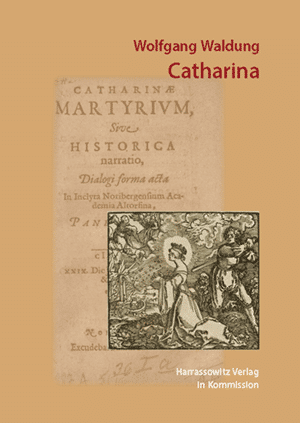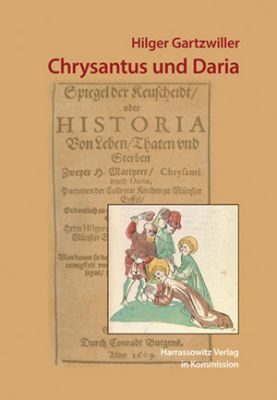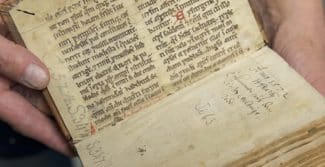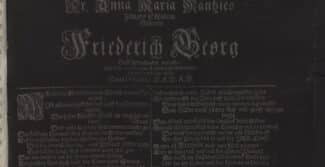8 April 2020
The edited critical edition of the dramas addresses how the theme of dying for the right faith was brought to the stage in response to the introduction of, or the fight against, Protestantism in the 16th and 17th centuries.
In volume 6, editor Karolin Freund presents the drama Chrysantus and Daria. Hilger Gartzwiller, deacon of the collegiate church of Münstereifel, dedicated a play to two patrons from Münstereifel, which was staged in 1606 at the church. As a Catholic drama, it emphasises rather different aspects of the Protestant dramas in the series. Chrysantus appears at the beginning with the Bible and confesses: ‘A Christian man is what I need/ Who can explain this book indeed’ (V. 415f.) Only after an introduction to biblical exegesis is he able to spread the right doctrine. This includes a life of chastity defended by God through miracles that are made visible to the audience. The multiple attempts to kill the two megalomartyrs are also shown openly. The play is clearly set in the context of a piety that centres on visions of the sacred. At the end the two saints are retrieved from their graves by singing angels and taken to God as ‘hostia vivens’ (V. 3251b). The epilogue closes the play on a very Catholic note, calling for obedience and fear of God.
Catholic non-Jesuit martyr plays were rare in Germany (in contrast to Switzerland); the idea of the martyr was primarily of interest to the Lutheran communities, who identified with the early church, which was persecuted by Rome. The martyr dramas were performed both in the circles of Lutheran princely houses and in imperial and Hanseatic cities, mostly after the promulgation of the religious Peace of Augsburg in 1555, which guaranteed the coexistence of the two confessions, rendering confessional foes both visible and approachable.
It was less Rome at whom Braunschweig pastor Melchior Neukirch took aim in writing Stephanus (1591) than his archenemies, the Crypto-Calvinists, who in 1580 had divided the population. His play was a show of support for the Lutheran clergy of Braunschweig. Thus the drama, which evokes the unity of the early church community, also spills out into the city as a whole. In the fourth act we are told that anyone who wants to see the ‘spectacle’ of the clerics being killed ‘should swiftly proceed / to the marketplace’ (V. 3503f.). Together the (all-male) cast and the audience of citizens/burghers made their way from the Petrikirche to the Altstadtmarkt. By taking part in the procession with Stephanus and the apostles, the audience demonstrated their affiliation with the early church community. Having arrived at the marketplace, Stephanus is increasingly presented in the image of Christ. He dies at the city’s official site of public execution with a view of the heavens that are already open to receive him – as symbolised by the Lutheran Martinikirche.
Yet Lutheran martyr dramas did not shy away from legendary saints either. Balthasar Thamm staged his Dorothea in the Altenburger Schloss, in honour of Dorothea Maria von Anhalt. The play models her educational approach: the saint causes great offence by teaching the catechism to a gaggle of schoolgirls. Her stoical, nigh-on unshakable manner provokes aggression in the Powers of Hell; only once does she briefly react in anger – when a procuress (like Satan in the wilderness with Christ) is convinced she can seduce her. Of course, she perishes uttering Christ’s name. Holy men and women who work miracles after their death contradict the Lutheran understanding of saints. Dorothea’s attribute and identifying symbol are roses, which she is said to have sent to her tormentors from Heaven after her death. Thamm could not omit the miracle of the roses and therefore interpreted it as a miracle of Christ. In response to this miracle, he has the ‘people’ (with whom Thamm’s noble audience are encouraged to empathise) decide to abolish idolatry. They ‘wanted only to place their trust in Jesus Christ / Who is the true helpmeet’ (V. 2930f.) – as opposed, that is, to relying on a saint’s intercessory prayer.
Catharine of Alexandria is a yet more unusual Protestant saint and the protagonist of a play in Latin that the philologist Wolfgang Waldung had performed by students in 1602 to mark the 25th anniversary of the Academia Altdorfina. As the patron saint of Nuremberg and the faculty of arts, Catharine made a fitting choice for the theme of the anniversary speech, which addressed hostility towards seekers of wisdom. Waldung avoided all association with Jesuit ‘St Catharine plays’, instead following a humanist model and with it adopting the pantheon of classical gods. These gods, and a host of historical examples from antiquity, underscore the scholarly character of a drama about a learned saint, who in a disputation contest beats the pagan philosophers and converts them to God’s word. The content of the theological debate is only experienced by the audience through the commemorative addresses of other figures, who cite the key elements of Lutheran doctrine.
Protestant martyr dramas are characterised by their emphasis on doctrine, impressive in its simplicity, and on the proclamation of the ‘pure’ Word of God, as intelligible in itself (sola scriptura). Despite the static attitude of the teaching and preaching saints, the plays are not lacking in drama, with the active part played by the forces of evil. Feeling threatened, the saints take up their crosses and remain extremely Christ-centred right up to their deaths. The Catholic dramas, by contrast, present saints in the process of learning, for whom the right understanding of the Word and the right life are rolled into one. The plays rely on visible effects; they cite the sacraments as evidential forms of the transmission of salvation and they present miracles, which confirm God’s favouring of the saints in life and their presence and salvific function for people after their deaths.
The project on the enactments of saintliness within the context of confessional conflicts was developed by Cora Dietl during a residency at the HAB in summer 2012 and has had funding from the Deutsche Forschungsgemeinschaft (German Research Foundation, DFG) since 2014. Together with Julia Gold, Karolin Freund, Verena Linseis and Björn Reich, she researches how German and Swiss martyr dramas of the 16th and 17th century use theatrical and literary strategies of persuasion and polemics and how the dramas respond to local circumstances. The seventh and eighth volumes featuring Jacobus und Petrus by Arnold Quiting (1593) and Felicitas by Mathaeus Steffan (Stessan, 1589) will complete the work. More information on other volumes issued by the publishers can be found here.
The author
Prof. Cora Dietl holds the Chair of German History of Literature (with a focus on the Middle Ages and early modern era) at the Justus-Liebig-Universität Giessen. Her research is focused on the theatre of the Late Middle Ages and the early modern era, the Arthurian epic of the High and Late Middle Ages and regional German literature of the Middle Ages in Eastern Europe. She is a corresponding member of the Austrian Academy of Sciences and Vice Chair of the Philosophical Faculty Association.
More on the author








